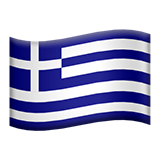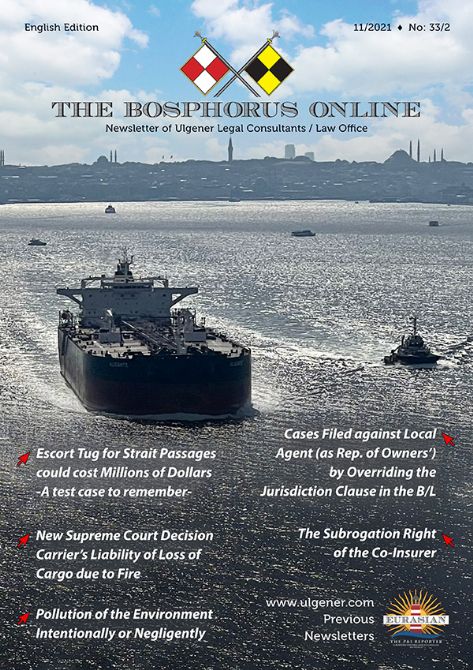
Ulgener
Prof.Dr.M.Fehmi Ülgener
Since almost a decade the regulation requires strait passages for certain vessels[1] to be done with an escorting tug (“CSA”, father of the notorious “TOF”). The reasoning behind this is that strait passages are containing elevated navigational perils, since the area where a technical malfunction occurs provides almost no manoeuvrable space to the vessel in trouble; therefore an extra hand would be warmly welcome during such moments when the vessel cannot avoid a danger by her own means.
According to the regulations, upon certain payment of fees, CSA provides this “extra hand” service to the vessels by providing a tugboat to escort, i.e. to sail in close proximity of the vessel from the commencement of the strait passage until it finishes and the vessel clears the strait boundaries.
As the tugboat escorting fees are included in the freight/hire rates of the owners calculations, such payment is nothing else but one of the routine expenses of the intended voyage, therefore it is within the comfort zone of the owners… well this is until the vessel needs the extra hand, i.e. the moment the incident for which the escorting tug boat hired occurs and renders her services to the vessel, the owners will leave their comfort zone to an uncharted territory. According CSA this situation constitutes a straightforward “salvage”, as if that tugboat was not hired for avoiding the perils involved in a strait passage.
In summer 2021, during the Bosphorus passage with escort tug, a tanker encountered technical problem and started drifting. The escorting tugboat rushed alongside the vessel and (so to say) gave a short shoulder on her bow, which changed the course of the drifting to open seas. At that time the technical problem was also solved and the tanker got control of her own navigation.
During the time of the class survey onboard the vessel, master has been informed that the vessel has been detained by the Port Authority, upon the request of the CSA due the demand of remuneration for salvage.
Our office has been instructed to represent the master and the owners by the H&M underwriters. Although we tried to convince the CSA that the escort tug has done what it was paid for, but to cut the story short, owners (h&m uw) were forced to put up a bank letter of guarantee amounted almost six million dollars to release the vessel and resume her voyage.
This is an ongoing problem for the strait passages and it is not something rare; our office only involved at least five similar cases before, and we can imagine that there are more cases like this. What made this case different from the others is that underwriters were determined this time to instruct us to run a test case against CSA at the admiralty court on the subject whether a tugboat can claim salvage for her not unexpected and unusual actions which she was already contracted and got paid to perform. We believe that the test case will have an important effect on the future conduct of strait passage for the global shipping community. But in the meantime please bear in mind that according to present regulations and customs, the tugboat for which you paid for can ask a couple of million dollars as a salvage claim!
[1] Article 15 (Implementation Directive For the Regulation Regarding Sea Traffic Scheme in Turkish Straits)
1.Vessels with the following properties shall pass through Istanbul Strait during the daytime.
a. Vessels with a full length of 200 meters and above specified in clause (s) of the first paragraph of Article 2 of this Directive, except for Ro-Ro and container ships.
b.All vessels transiting under tow
c. Vessels subject to additional passage conditions.
d.All vessels with full lengths of 250 meters and above.
e. Deep draft vessels.
2.It is strongly recommended that vessels specified in the first paragraph pass through the Strait under the assistance of a pilot and under the escort of appropriate number and bollard pull as specified in clause (e) of the first paragraph of Article 7 of this Directive.
3.The following issues taken into considerations during the planning for Istanbul Strait passage
a. The passages of Ro-Ro and container ships carrying dangerous goods with an LOA between 150 and 250 meters to effected under pilotage assistance and their passage shall be planned to be at least 6 nautical miles apart from other ships carrying dangerous goods with an LOA of 150 meters and over.
b.The passages of Ro-Ro and container ships carrying dangerous cargoes with an LOA of 250 meters and over will be effected under the assistance of pilots and their passage shall be planned to be at least 8 nautical miles apart of others vessels of 150 mtrs LOA and carrying dangerous cargo .
4.Vessels whose specifications are given below shall pass through Dardanelles Strait during the daytime.
a. Vessels with full lengths of 250 meters and above specified in clause (s) of the first paragraph of Article 2 of this Directive, except for Ro-Ro and container ships,
b.Vessels whose LOA is 200 meters and over specified in sub-paragraphs 1,4 and 6 of sub-clause (s) of the first paragraph of Article 2 of this Directive
c. Vessels with an LOA of 200 meters and over carrying IMDG Code Class 1 cargo,
d.Deep draft vessels.
5.It is strongly recommended that vessels specified in subparagraph (a) of the fourth paragraph carry out the Dardanelles passage with a maritime pilot and tugboats in the number and with the bollard pull specified in clause (e) of the first paragraph of Article 7 of this Directive.



